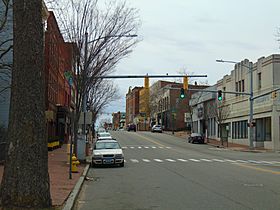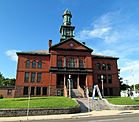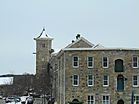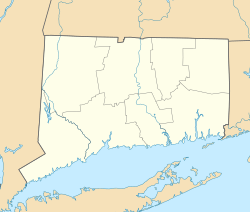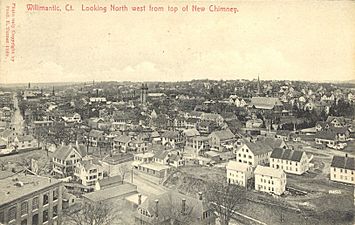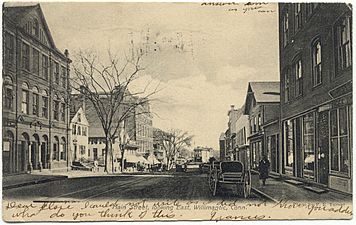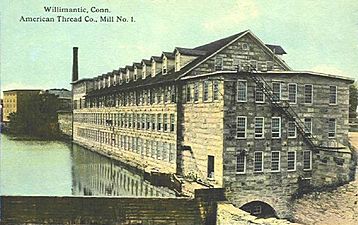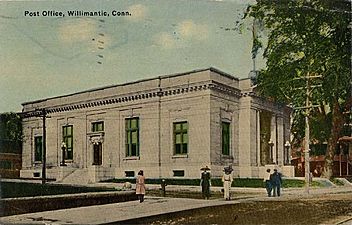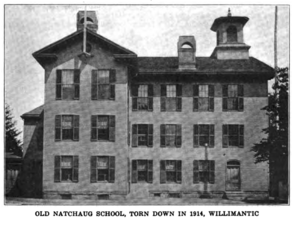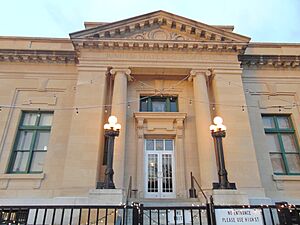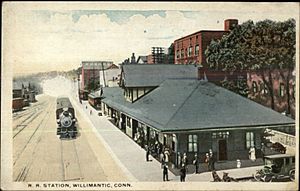Willimantic, Connecticut facts for kids
Quick facts for kids
Willimantic, Connecticut
|
||
|---|---|---|
|
From top to bottom, left to right: The view of the center of Willimantic from Route 66, the Willimantic Footbridge, a well known bridge, a railroad yard, the Willimantic Armory, the Windham Town Hall, and the American Thread Company's former mill
|
||
|
||
| Nickname(s):
Thread City, Frog City
|
||
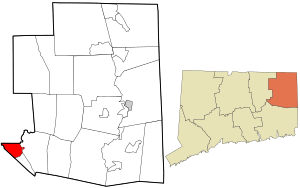
Location in Windham County and Connecticut
|
||
| State | ||
| County | Windham | |
| Area | ||
| • Census-designated place | 11.6 km2 (4.5 sq mi) | |
| • Land | 11.4 km2 (4.4 sq mi) | |
| • Water | 0.3 km2 (0.1 sq mi) | |
| Population
(2010)
|
||
| • Census-designated place | 17,737 | |
| • Estimate
(2018)
|
17,550 | |
| • Density | 1,556/km2 (4,030/sq mi) | |
| • Urban | 29,669 | |
| Time zone | UTC-5 (Eastern) | |
| • Summer (DST) | UTC-4 (Eastern) | |
| Airport | Windham Airport | |
| Major highways | ||
Willimantic is a special area in the town of Windham, located in Windham County, Connecticut, United States. It used to be a city and a borough. Today, it's one of two special tax districts within the Town of Windham.
Willimantic is often called "Thread City" because of the American Thread Company's mills along the Willimantic River. In the 1800s, it was a major center for making textiles. The city grew a lot after it was officially formed in 1893. However, after World War II, the mills closed, and Willimantic became part of the town of Windham again in the 1980s. Even though it was a big train hub, a major highway never came close to it.
Many different groups of people moved to Willimantic to work in the mills. These included immigrants from Western Europe, French Canada, Eastern Europe, and Puerto Ricans. The town is known for its beautiful Victorian-era houses. It also has the Windham Town Hall and two famous bridges over the Willimantic River: a footbridge and the "Frog Bridge". Willimantic is home to Eastern Connecticut State University and the Windham Textile and History Museum. In 2010, about 17,737 people lived there.
Contents
Willimantic's Past: A Look at Its History
What Does the Name Willimantic Mean?
The name Willimantic comes from an Algonquian word. It means "land of the swift running water." This name perfectly describes the fast-moving Willimantic River that flows through the area.
Early Days: How Willimantic Grew
Before 1821, Willimantic was a small village called Willimantic Falls. Only about twenty families lived there. In 1822, Charles Lee built the first factory on Main Street. It was made of stone from the Willimantic River. This factory started the industrial growth of Willimantic.
In 1825, the Jillson brothers built another factory along the river. By 1828, there were six cotton factories in Willimantic. The town became known as "Thread City" because of the American Thread Company. This company had a huge mill there and was once the largest employer in Connecticut. It was also one of the biggest thread makers in the world. Their factory was the first in the world to use electric lights. Willimantic became a borough in 1833 and then a city in 1893.
City Life: Growth and Change
From the end of the Civil War until World War II, Willimantic was a major center for making silk and cotton thread. Many immigrants came from Europe to work in the mills. These included people from Ireland, Italy, Poland, Germany, and French Canadians. Later, immigrants from Estonia, Ukraine, Latvia, Lithuania, and Puerto Rico also moved to Willimantic for mill jobs.
Railroads also helped Willimantic grow. In the 1890s, the town was a stop for the fast "White Train" between Boston and New York. In the early 1900s, 50 to 100 trains passed through Willimantic daily. More than 800 fancy Victorian homes were built in the Prospect Hill area. This area is now listed on the National Register of Historic Places. The town grew from less than 5,000 people in 1860 to over 12,100 by 1910.
Recent Times: Challenges and Comeback
After many years, the American Thread Company moved to North Carolina in 1985. This caused the town's economy to struggle. In 1983, the city and the town joined together again.
Today, many projects are helping Willimantic improve. The Willimantic Whitewater Partnership wants to create a whitewater park along the river. Some old factory buildings have been turned into homes for artists by Artspace. Other former factories are now spaces for small technology companies. In 2008, Bizjournals.com ranked Willimantic as the 43rd most desirable town in the country. This was based on its quality of life and location.
Photos from Willimantic's Past
Fun Things to See and Do in Willimantic
Cool Events and Festivals
- Willimantic Boom Box Parade: This parade is famous for being unique. In 1986, a local fan named Kathleen Clark suggested playing music from boom boxes. People bring their radios and tune into WILI (AM) to hear patriotic marches. This parade has no live music, which makes it special. It has even been featured on national news.
- 3rd Thursday Street Fests: From May to September, on the third Thursday of each month, Main Street comes alive. Willimantic Renaissance, Inc. hosts a festival with music, theater, and delicious food. There are six stages with different types of entertainment. You can try international foods and local drinks. About 100 vendors and crafters fill the streets. This event is organized by volunteers and draws about 8,000 people.
- Victorian Days in Willimantic: This event happens on the first weekend in June. It's put on by the Willimantic Victorian Neighborhood Association. You can take tours of old homes, enjoy Victorian teas, and go on trolley rides. There are also art shows, museum visits, and concerts.
Interesting Places to Visit
- Willimantic Food Co-op: This is the only storefront food cooperative in Connecticut. It started as a buyers' club and opened on Main Street in 1980. It has moved to bigger locations over the years. The Co-op hosts the Downtown Country Fair every autumn. This fair has a farmer's market, live music, food, and crafts.
- Willimantic Footbridge: Built in 1907, this is the only footbridge in the United States that connects two state highways. It also crosses a road, a railroad, and a river.
- Prospect Hill Historic District: This area has 993 historic buildings. About 88% of them add to its special old architectural style. It is one of the largest historic districts in Connecticut.
- Thread City Bread: Willimantic once had its own local currency called "Thread City Bread." This money could be used at many local businesses.
- Thread City Crossing ("The Frog Bridge"): This bridge opened in 2001 and has a unique design. It has eight-foot-tall bronze frogs sitting on concrete thread spools. The spools show Willimantic's history in making thread. The frogs represent a local legend called the Windham Frog Fight of 1754.
- The Garden on the Bridge: This narrow stone arch bridge was built in 1857. In 2006, it became the Windham Garden on the Bridge. It was dedicated to Virginia Darrow, who started the Garden Club of Windham. Volunteers from the Garden Club and Public Works employees take care of the gardens.
- The Connecticut Eastern Railroad Museum: This museum is located in downtown Willimantic. It's on the original site of the Columbia Junction Freight Yard. You can see old locomotives, train cars, and historic railroad buildings. It even has a six-stall roundhouse that was rebuilt on its original foundation.
- Willimantic Brewing Company: The old post office building now houses this local pub.
Willimantic's Location and Environment
Geography and Rivers
Willimantic covers about 4.5 square miles (11.6 square kilometers). Most of this area is land, with a small part being water. The Willimantic River flows through the area.
Weather in Willimantic
| Month | Jan | Feb | Mar | Apr | May | Jun | Jul | Aug | Sep | Oct | Nov | Dec | Year |
|---|---|---|---|---|---|---|---|---|---|---|---|---|---|
| Record high °F (°C) | 69 (21) |
72 (22) |
82 (28) |
93 (34) |
95 (35) |
98 (37) |
100 (38) |
100 (38) |
100 (38) |
88 (31) |
80 (27) |
75 (24) |
100 (38) |
| Mean daily maximum °F (°C) | 35.3 (1.8) |
38.4 (3.6) |
47.3 (8.5) |
59.3 (15.2) |
70.1 (21.2) |
78.0 (25.6) |
82.3 (27.9) |
80.8 (27.1) |
73.8 (23.2) |
62.1 (16.7) |
51.9 (11.1) |
40.3 (4.6) |
60.0 (15.5) |
| Daily mean °F (°C) | 29.0 (−1.7) |
31.7 (−0.2) |
38.3 (3.5) |
48.1 (8.9) |
57.9 (14.4) |
67.7 (19.8) |
73.4 (23.0) |
72.1 (22.3) |
64.9 (18.3) |
54.0 (12.2) |
44.7 (7.1) |
34.7 (1.5) |
51.4 (10.8) |
| Mean daily minimum °F (°C) | 17.0 (−8.3) |
19.6 (−6.9) |
26.3 (−3.2) |
36.2 (2.3) |
45.9 (7.7) |
55.5 (13.1) |
61.0 (16.1) |
59.9 (15.5) |
51.4 (10.8) |
39.6 (4.2) |
31.4 (−0.3) |
22.3 (−5.4) |
38.8 (3.8) |
| Record low °F (°C) | −27 (−33) |
−21 (−29) |
−16 (−27) |
6 (−14) |
22 (−6) |
30 (−1) |
37 (3) |
32 (0) |
20 (−7) |
15 (−9) |
1 (−17) |
−18 (−28) |
−27 (−33) |
| Average precipitation inches (mm) | 3.36 (85) |
3.25 (83) |
4.32 (110) |
3.74 (95) |
3.49 (89) |
3.68 (93) |
3.43 (87) |
3.35 (85) |
3.44 (87) |
3.94 (100) |
3.99 (101) |
3.78 (96) |
43.77 (1,111) |
| Average snowfall inches (cm) | 8.1 (21) |
11.1 (28) |
5.5 (14) |
1.1 (2.8) |
0.0 (0.0) |
0.0 (0.0) |
0.0 (0.0) |
0.0 (0.0) |
0.0 (0.0) |
0.0 (0.0) |
0.9 (2.3) |
6.7 (17) |
33.4 (85.1) |
| Average precipitation days (≥ 0.1 in) | 6 | 6 | 7 | 7 | 8 | 7 | 6 | 5 | 6 | 6 | 6 | 7 | 72 |
| Average snowy days (≥ 0.1 in.) | 4 | 4 | 3 | 0 | 0 | 0 | 0 | 0 | 0 | 0 | 1 | 2 | 15 |
| Source: | |||||||||||||
Who Lives in Willimantic?
| Historical population | |||
|---|---|---|---|
| Census | Pop. | %± | |
| 1880 | 6,608 | — | |
| 1890 | 8,648 | 30.9% | |
| 1900 | 8,937 | 3.3% | |
| 1910 | 11,230 | 25.7% | |
| 1920 | 12,330 | 9.8% | |
| 1930 | 12,102 | −1.8% | |
| 1940 | 12,101 | 0.0% | |
| 1950 | 13,586 | 12.3% | |
| 1960 | 13,881 | 2.2% | |
| 1970 | 14,402 | 3.8% | |
| 1980 | 14,652 | 1.7% | |
| 1990 | 14,746 | 0.6% | |
| 2000 | 15,823 | 7.3% | |
| 2010 | 17,737 | 12.1% | |
| 2020 | 18,149 | 2.3% | |
| U.S. Decennial Census / Social Explorer Map |
|||
Many different groups of people have moved to Willimantic over the years. First, Europeans came to work in the mills. These included people from Ireland, Italy, Poland, Germany, and French Canadians. Later, immigrants from Estonia, Ukraine, Latvia, Lithuania, and Puerto Rico also came for mill jobs.
Because so many different groups settled here, Willimantic has many churches. For example, there are different Catholic churches for French Canadians, Irish, Polish, and Italian immigrants.
In 2010, there were 17,737 people living in Willimantic. About 34.2% of households had children under 18. The average household had about 2.58 people. The median age was 26.5 years old. This means half the people were younger than 26.5, and half were older.
The population included 66.0% White people, 7.5% African American, and 20.2% from other races. About 39.8% of the population was Hispanic or Latino, mostly Puerto Ricans.
Willimantic's Economy and Jobs
Willimantic's first factory was built in 1822 by Charles Lee. The Jillson brothers built their first mill in 1824. In 1854, investors bought the Jillson Mills and formed the Willimantic Linen Company. This company built Mill No. 4 in 1880. It was the first factory designed for electric lighting and the largest cotton mill in the world at the time.
The American Thread Company bought the Willimantic Linen Company in 1898. They made even more thread. However, the mill closed in 1985 when the company moved its operations.
Today, major employers include Willimantic Waste Paper Company. This company collects and recycles paper, metal, and plastic. Another important company is Brand-Rex Corporation, which makes special wires and cables. In 2018, a fire destroyed the Willimantic Waste Paper plant, but it was rebuilt and is working again. In 2021, Casella Waste Systems bought the company.
Schools and Learning in Willimantic
Willimantic has public schools managed by Windham Public Schools. These include the Windham Early Childhood Center for preschool, Sweeney Elementary and the Natchaug School for younger students, and Windham Middle School. For high school, students attend Windham High School. Middle school students can also try to get into the Charles H. Barrows STEM Academy.
Other schools in Willimantic include the Arts at the Capitol Theater Performing Arts High School. There is also Windham Technical High School, which is part of the Connecticut Technical High School System. For private education, there is St. Mary-St. Joseph School, which serves students from pre-kindergarten to eighth grade.
Willimantic is also home to Eastern Connecticut State University. This is a four-year college focused on liberal arts. A smaller campus of Quinebaug Valley Community College is also located here.
Getting Around Willimantic: Transportation
Willimantic is connected by several state roads: Route 14, Route 32, Route 66, Route 195, and Route 289. It also has the Willimantic Bypass (US 6). This bypass helps traffic move around the town.
Public transportation is provided by the Windham Region Transit District. They offer two bus routes within the town. They also have three routes that connect Willimantic to nearby towns like Norwich, Danielson, and Storrs. In the past, Willimantic also had trolley service.
In the 1800s, three main train lines passed through Willimantic. These lines connected places like New London, Vermont, Hartford, Providence, Boston, and New York. Willimantic was a busy train junction. At its busiest, about forty passenger trains passed through Willimantic every day. However, passenger train service ended in 1955 after a bridge was damaged by Hurricane Diane.
Today, no passenger trains stop in Willimantic. The Windham Airport (IJD) is a small airport nearby for private planes. The closest major airport for commercial flights is Bradley International Airport (BDL) in Windsor Locks.
Willimantic also has several trails for walking and biking. The Airline Trail South crosses the Willimantic River. The Airline Trail North starts on Jackson Street. The Hop River Trail also enters Willimantic and follows the river.
Images for kids
See also
 In Spanish: Willimantic (Connecticut) para niños
In Spanish: Willimantic (Connecticut) para niños


